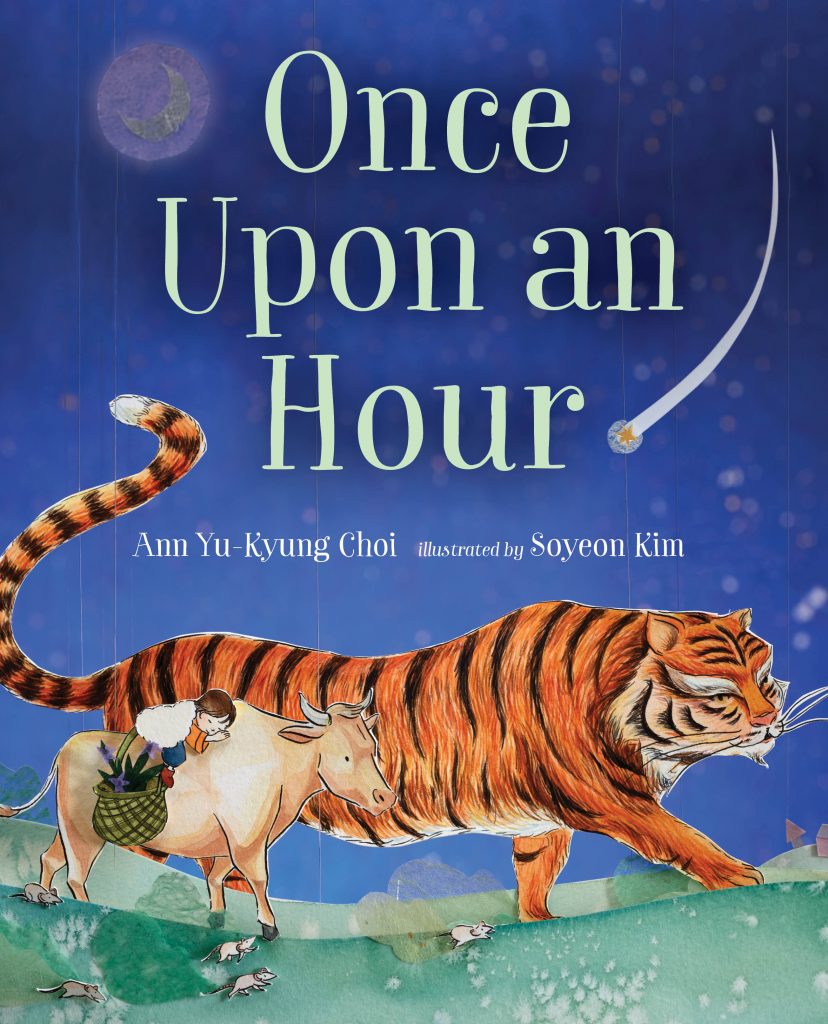
Ann Yu-Kyung Choi is the author of Once Upon an Hour, illustrated by Soyeon Kim and out October 13. In this picture book, Yu-Rhee, a young Korean girl, wants to know how to tell time using a clock. Her mother tells her a tale from her childhood based on the traditional Korean practice of timekeeping, where the 12 animals of the zodiac are assigned to 2-hour sections of the 24-hour clock.
In a guest post for the Orca Blog, she explains how her own grandmother taught her about this Korean timekeeping practice.
* * *
By Ann Yu-Kyung Choi
As we had no TV, my great-grandmother’s stories were largely what entertained me and my brothers. She never read to us. Years later I understood why— she was illiterate, never having gone to school. It was from her that I first learned the Korean versions of the hare and the tortoise, the lion and the mouse, and Korea’s creation myths.
Although my great-grandmother lived with us in Chung-Ju, a city in South Korea, she didn’t use a clock to tell time. She said it was useless growing up on a farm where the rooster woke her up every morning. Instead, she taught us about the ancient Korean practice of using animals to mark the hourly passage of time. For example, 12:30 a.m. would be referred to as the third quarter of the “rat hour.” The 12 animals also represented a year within the 12-year lunar cycle. Like many others, my great-grandmother, grandmother and mother were highly superstitious. Since I was a “monkey” child, they feared that bad things might happen to me (like nightmares) during the “tiger hour” (3:00 a.m – 5:00 a.m.), as tigers are a monkey’s foe.

My daughter is half-Korean and half-Irish. In crossing an ocean to live in Canada, I have come to realize that many of the oral Korean stories that I learned in my childhood would become lost to my daughter and her generation. While books on Korea’s textbook history are plentiful, stories about ancient timekeeping and the myths and beliefs that were largely influenced by Shamanism, Buddhism and Confucianism have not yet been widely shared with international readers.
Once Upon an Hour aims to inform young readers that there are many different ways of telling time. In Korea it was once popular to watch the sky and measure time using the sun, the moon and the stars. My great-grandmother would without fail know which direction was north and observe the shadows change in direction and length to tell us it was time to eat or play.
Finally, I wanted to capture another important cultural tradition in my story. Doraji, a flower that grows wild in northern Korea, is known for its medicinal powers. In 1953, Korea became a divided nation. This meant that people could not travel back and forth and families were separated. The song “Doraji” that the child in my story sings represents loss. While the plant doraji heals the body, it plagues the soul because it is a constant reminder of Korea’s sad division. The song continues to be celebrated in folk music and dances with the hope that Time will one day bring peace to the nations.
A Different Way of Telling Time
11:00 p.m. to 1:00 a.m. is the hour of the Rat.
1:00 a.m. to 3:00 a.m. is the hour of the Cow.
3:00 a.m. to 5:00 a.m. is the hour of the Tiger.
5:00 a.m. to 7:00 a.m. is the hour of the Rabbit.
7:00 a.m. to 9:00 a.m. is the hour of the Dragon.
9:00 a.m. to 11:00 a.m. is the hour of the Snake.
11:00 a.m. to 1:00 p.m. is the hour of the Horse.
1:00 p.m. to 3:00 p.m. is the hour of the Sheep.
3:00 p.m. to 5:00 p.m. is the hour of the Monkey.
5:00 p.m. to 7:00 p.m. is the hour of the Chicken.
7:00 p.m. to 9:00 p.m. is the hour of the Dog.
9:00 p.m. to 11:00 p.m. is the hour of the Pig.
Ann Yu-Kyung Choi immigrated to Canada from South Korea in 1975. She attended the University of Toronto where she studied English, sociology and education. Her debut novel, Kay’s Lucky Coin Variety (Simon & Schuster), was a 2016 Toronto Book Awards finalist and one of CBC Books’ 12 Best Canadian Debut Novels of 2016. Ann is an educator with the York Region District School Board in Ontario. She lives in Toronto with her family


